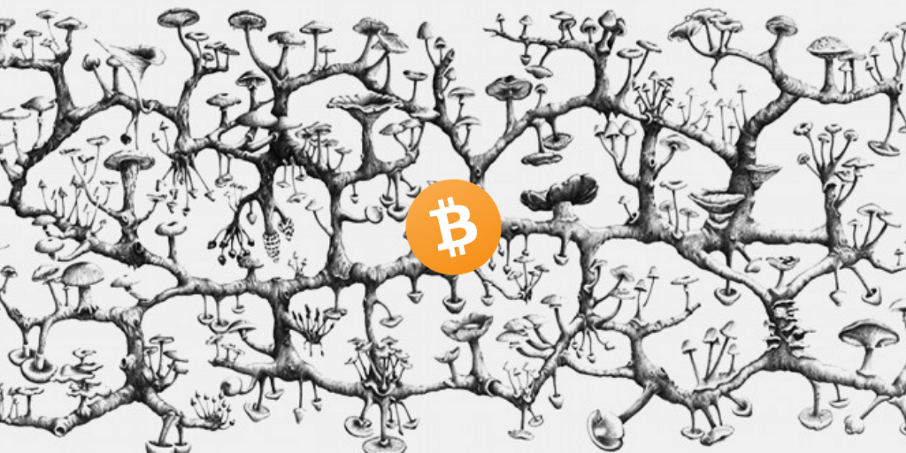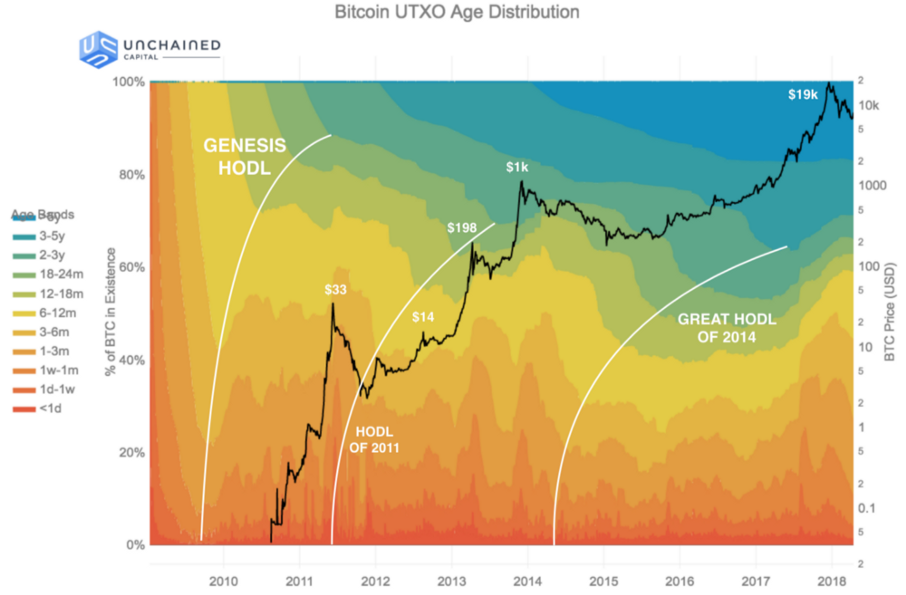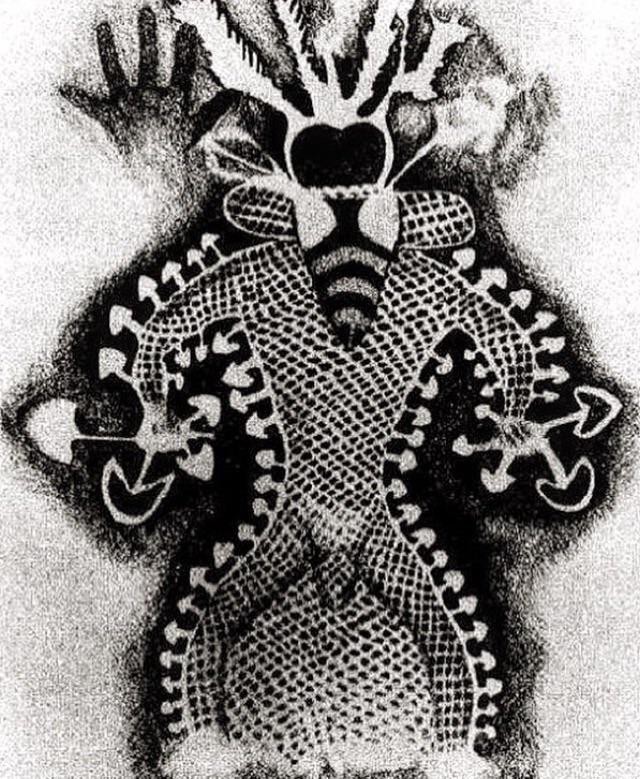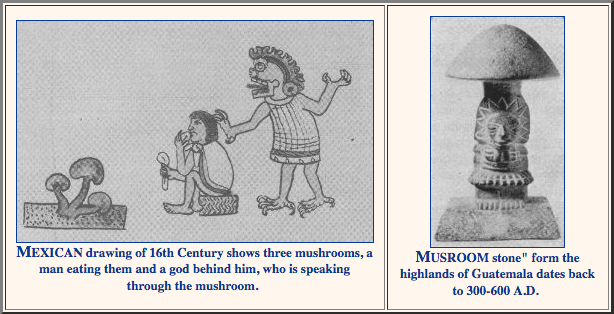Bitcoin is a Social Creature (Mushroom) — Part 2/4
Bitcoin is a Social Creature (Mushroom) — Part 2/4
By Brandon Quittem
Posted December 28, 2018
- Part 1 - Bitcoin is a Decentralized Organism
- Part 2 - Bitcoin is a Social Creature
- Part 3 - Bitcoin is the Antivirus
- Part 4- To Be Posted
Exploring Hype Cycles, Ethnomycology, and the Cult of Satoshi
 Original Artwork by Richard Giblett
Original Artwork by Richard Giblett
Introduction
In my last article, “Bitcoin is a Decentralized Organism” we explored bitcoin’s decentralized architecture through the lens of mycelium. We covered the decentralized network archetype, antifragility, PoW, arbitrage, bitcoin’s role in it’s ecology, and the merits of decentralization.
However, our fungi story is not yet complete. The next stage in the fungal life cycle is to reproduce and this all happens inside the mushroom. After reaching maturity, mushrooms release little mushroom seeds called spores capable of colonizing new territory.
Although the fungi kingdom is quite alien compared to life in the animal kingdom, humans have had a relationship with mushrooms for a long time. Historically, mushrooms have represented mystery, fear, opportunity, impermanence, and to some a cult-like reverence.
In this article, we’re going to explore bitcoin as a social phenomenon through the lens of the mysterious mushroom.
Disclaimer: If you’re new to the fascinating world of fungi, I recommend starting with part 1.
Short on time? Here’s a condensed version: https://twitter.com/bquittem/status/1072864756296486913
Bitcoin is a Social System Ratified by Code
Bitcoin is made up of individual constituents each with their own perspectives, motivations, and abilities. Collectively they form consensus on the rules of the bitcoin game. The code simply ratifies this social consensus.
From Hasu’s seminal piece Unpacking Bitcoin’s Social Contract:
“The Bitcoin protocol automates the contract that is agreed upon on the social layer, while the social layer determines the rules of Bitcoin, based on the consensus of its users. They are symbiotic: Neither would be sufficient without the other.”
Humans are messy, emotional, predictably irrational beings. Bitcoin, being comprised of a network of humans, is no different.
Section #1: Human Psychology, Hype Cycles, and the Mushroom Method
Fungi exist primarily in their “mycelium form” which you can think of as an underground root system connecting trees and plants. Humans wouldn’t even know mycelium exists as it stays quiet underground for the majority of its life.
However, when fungi sense that conditions are favorable (temperature, humidity, etc), it sends up a mushroom above ground. These mushrooms are the sexual organs of fungi — essentially phallic spore (seed) delivery systems.
Before mushrooms break the ground, fungi concentrate energy into a tiny mass of cells underground called “pinheads” which persist until the perfect moment. Then, seemingly out of nowhere, mushrooms explode out of the ground doubling in size each day until reaching maturity.
Fungi Fact #1: Some fungi can produce mushrooms with enough force to break through asphalt.
After the mushroom is fully mature it crescendos with a release of millions of spores (mushroom “seeds”) before quickly decomposing back into the ground.
The mushroom only lives for a few triumphant days and most spores perish before infancy, however a small percentage of the spores will travel nearby and form new fungal colonies. These new colonies might stay underground for several years before the reproductive cycle continues again.
Fungi Fact #2:Spores are lighter than air which makes travel easy. Theoretically spores could catch an updraft and leave earth’s orbit. Luckily, they’re on a short list of biological matter capable of surviving the cold vacuum and radiation of space. Panspermia anyone? Save your tinfoil hats for part 3 ;)
Mushroom Timelapse porn
Bitcoin’s Hype Cycles Parallel Fungal Reproduction
To the casual observer, most of bitcoin’s life is boring — months go by with relatively little action. Then when conditions are just right, bitcoin explodes into life, growing massively in size, and hijacking the consciousness of observers. Price goes to the “moon,” media is flooded with hyperbole, and “DMs from normies” flood in.
Then almost as soon as it crescendos, bitcoin fades away, dying back into obscurity as casual participants write it off as a fad, hype, or a failed experiment. Like the mushroom spores, most new users exit the ecosystem. However a small percentage form new colonies in bitcoin land. These bear market survivors become new “hodlers of last resort.”
Unsurprisingly, the bear market narrative is driven by surface level activity (price).
Bitcoin Detractors Mistake the Hype Cycle (Mushroom) for the Big Picture (Mycelial Network)
Amnesiac pundits proudly pile on proclaiming bitcoin has perished (for the 335th time). Fiat maximalists take victory laps on twitter by posting 12 month charts.
“You’re missing the mycelium for the mushroom!” h/t Nic Carter
Roubini celebrates by hosting his 3rd bear market barbecue. Detractors gather to roast the proverbial (bitcoin) mushroom while patting each other on the back.

However to be fair, bitcoin is complicated. Many “crypto people” still think bitcoin is myspace and Ripplecoin is the “standard.” Unsurprisingly most journalists don’t grasp what’s going on. Imagine being assigned the “bitcoin beat” as a well intentioned, run-of-the-mill journalist.
While the mushroom has died (recent hype cycle), the mycelium (bitcoin) is thriving underground.
Like a mushroom past its prime, bitcoin exuberance decays and the price plummets. This bear market will shake out weak hands, hedge funds will fail, ICOs will give back investor money or worse, projects will fail, and some charlatans will be exposed.
However hodlers, new and old, collectively go underground and quietly make bitcoin better: building, learning, and forming alliances.
Bitcoin has improved dramatically in 2018:
- Lightning Network is picking up momentum
- SegWit adoption grows to around 40% improving transaction throughout
- New developers being groomed by Jimmy Song &Justin Moon
- The Block sets the standard for journalism in the space
- Casa,Pierre,Nodl, and others make running full nodes easier
- Nomics producing cleaner data than CMC
- Foundations laid for inevitable financialization (Fidelity, Bakkt, etc)
- Schnorr signatures are being built out (tech specs /whitepaper /TL;DR)
- Trace Mayer promotes “Proof of Keys” to minimize risk of rehypothecation + stress test ecosystem + remind new users about self sovereignty
- Blockstream enables bitcoin transactions via satellite. Things get interesting when combined with mesh networks.
- New metrics for measuring health of cryptocurrencies emerge such as Realized Cap, Economic Throughput, Economic Density ($/bytes), and MVRV.
- Passed the peak of miner centralization (bye bye Bitmain)
- Coinshares report says 77% of bitcoin’s energy consumption is from renewable sources
- New scribblers stand on the shoulders of giants attempting to describe bitcoin in novel ways.
As time goes on, narratives evolve as bitcoin continues to reveal herself (himself? itself?) to curious onlookers.
 (Hodl Waves by Dhruv Bansal at Unchained Capital)
(Hodl Waves by Dhruv Bansal at Unchained Capital)
Eventually the market bottoms. Hodlers cling together like a Band of Brothers creating a strong foundation capable of sustaining future growth.
“Hodlers are the revolutionaries“ — Dan Held
As hodlers hoard more bitcoin, the “float” (supply actively being traded) is increasingly constrained. With a decreasing available supply, each new user puts more upward pressure on the price. As price rises, media shines a spotlight, new users are pulled in, and before long we’re back in another hype cycle.
Section #2: Mycophobia, Maria Sabina, and the Cult of Satoshi
Sometimes people say crypto can be a bit “culty.” This is both true and a net positive. Before we get into bitcoin’s religious tendencies, let’s learn from our history with mushrooms.
The modern western world has been inflicted with “mycophobia” — the irrational fear of fungi. People fear what they do not understand, and let’s face it: most people think mushrooms are “vegetables.”
Mushrooms are strange. They represent the life-and-death cycle of impermanence that humans subconsciously fear. Facing our own mortality is no fun, better to just avoid it.
However, it hasn’t always been this way. In fact, humans have had a relationship with mushrooms for a long time. From food, to medicine, to superstitions and religious artifacts. Mushrooms can save your life, kill you, feed you, and even alter your consciousness.
Anthropological evidence suggests that humans who partnered with fungi had an evolutionary advantage. As more people understand fungi (and bitcoin), they’ll soon realize how important they just might be.
Humans Who Partner with Fungi have an Evolutionary Advantage
Ancient man relied on mushrooms to survive in the Alps of northern Italy. Ötzi, the Ice Man, who died nearly 5,300 years ago, was discovered carrying two mushrooms (Amadou and Birch Polypore) tethered on a leather strap. One of the mushrooms was used to start fires and the other was discovered to be medicinally active against the parasite discovered in his gut.
 (source)
(source)
As far back as 19,000 years ago, a particularly high status woman dubbed the “red lady” consumed mushrooms as evidenced by the spores recovered from her teeth. Whether this mushrooms was for food, religious purposes, or otherwise is unknown.
One of our oldest examples of cave paintings was discovered in northern Algeria, estimated to be over 6,000 years old. This painting depicted “bee man” who has mushrooms in his hands and growing out of his body.
 Cave painting: “Bee man” covered in mushrooms. Circa 4,000 BC
Cave painting: “Bee man” covered in mushrooms. Circa 4,000 BC
In Siberia, the Koryak people revered the “Fly Agaric” mushroom (Amanita Muscaria) which is the iconic “red and white” mushroom famously portrayed in Super Mario Brothers and Alice in Wonderland. The Koryak loved this mushroom so much they would drink the urine of humans and reindeer who recently consumed the mushroom. Apparently you can recycle urine in this way up to 5x while achieving desired effects. How they discovered this phenomenon is another question all together…
Get your tinfoil hat, the Fly Agaric may have inspired our Christmas traditions.
The Mazatec Culture from present day Mexico revered the mushroom as sacred. Discovered relatively recently by Gordon Wasson which he detailed in a famous article in a 1955 edition of Life Magazine. Many tourists have since visited this region in Mexico seeking to learn from the famous Mushroom Shaman, Maria Sabina, and her kin.
 Mushroom artifacts from Central America
Mushroom artifacts from Central America
Clearly the mushroom has captured the attention of our ancestors.
Bitcoin Conjures up a Similar Quasi-Religious Fervor
Described brilliantly by Yuval Noah Harari, Homo Sapiens are uniquely capable of cooperating flexibly in large numbers. This enables us to collectively agree on abstract concepts such as nations, gods, and money.
Just as humans formed religious cults around the mushroom, one way to describe bitcoin is a neo-money religious movement.
The mystery of Satoshi created a strong foundation enabling emergent religious tendencies.
Bitcoin was created through immaculate conception by a mythical character (Satoshi) who later sacrificed himself for the greater good.
The Cult of Satoshi inspires some fanatics to dedicate their lives to promoting the “good word.” Not all bitcoiners fall into the same religious sect. Some scholars cling to the ancient religious text (whitepaper) while others interpret Satoshi’s vision through his early forum posts.
Disagreements about priorities evidenced by the scaling debates have lead to hard forks and fractured “congregations.” Not unlike Martin Luther fracturing the catholic church by pinning the “Ninety-five Theses” on the church door in 1517.
Roger Ver was known as “Bitcoin Jesus” from his early days spreading the good word by gifting satoshis to fiat afflicted restaurateurs.
Messianic figures like Faketoshi (Craig Wright) spring up claiming to be the real Satoshi Nakamoto. Faketoshi, the fundamentalist, brands his sacrament as “Satoshi’s Vision,” the one true bitcoin as laid out in the “bible” (whitepaper).
“The functional details are not covered in the paper, but the sourcecode is coming soon.” — Satoshi Nakamoto
Nevermind how incomplete or how many errors are found in the whitepaper, Faketoshi claims his fork of a fork is the real “Satoshi’s Vision.” Even if Faketoshi’s fork WAS closest to Satoshi’s original vision (it wasn’t), does it even matter?
The answer is no. The essence of bitcoin is intimately tied to the ever evolving social consensus surrounding the protocol.
Each Rival Sect is a Competing Social Contract
Bitcoin’s social contract coalesces around a few simple rules. These agreed upon rules (a Schelling point) are then ratified in the bitcoin protocol automating social consensus.
 (Source: Hasu’s Bitcoin as a Social Contract)
(Source: Hasu’s Bitcoin as a Social Contract)
Let’s use the “great scaling debate” as an example. One group (BCH) believed we should focus on “cheap payments” at the expense of “decentralization,” while the other (BTC) believed we need to prioritize “decentralization” on the base layer and scale payments off chain.
As a competing religious sect in a free market, the BCash gang was free to fork the bitcoin code and test their hypothesis. One year later, it’s clear that the social consensus surrounding bitcoin doesn’t agree with the BCH approach as the market doesn’t value BCH or any other fork spawn.
Detractors of bitcoin might then say “forking bitcoin code inflates supply.”
However, that’s like saying when Zimbabwe prints more money it devalues the US Dollar. [h/t Murad]
In the case of the failed BCash fork(s), they copied the code (bitcoin protocol) but failed to mobilize the people (social layer) resulting in an asset with relatively minimal value. A prime example of bitcoin resisting corruption from bad actors by requiring social consensus in order to change the network.
In other words, bitcoin replaces social assumptions with mathematical assumptions. We will dive deeper into the consequences this has on our social scalability in part 3 (coming soon).
Religious Fanatic Behavior is an Indicator of Future Success?
We’re witnessing a new scarce commodity being monetized in real time. No living person has witnessed such a phenomenon.
In order to actually pull this off, the collective consciousness of the planet will need to change. Convincing people that money isn’t green paper and it doesn’t need to come from our government will take time.
In order to overcome the inevitable adversity required to create a new global reserve currency, it just might require some “religious zeal.” As each new disciple converts to the cult of Satoshi, the chances of hyperbitcoinization increase.
That being said, there are risks of over-politicizing bitcoin . [h/t Hasu ]
Some factions of the community portray bitcoin as a club for Austrian Economists who only eat meat that they personally shot with one of their many guns. While those things are well and fine, they are not prerequisites for being a bitcoiner. Let’s not entangle the two at the cost of repelling prospective bitcoiners.
Now, be sure to convince all your friends and family to read the New Testament ( The Bitcoin Standard ) at least twice before heading out on your next FUD Crushing Crusade.
Good Cults Have Incentives to Evangelize
Money is the ultimate network effect — its value is determined by the number of people you can interact with.
In bitcoin, not only does it capture its user’s imagination in a religious sense, but there are also financial incentives to recruit new members into the congregation. With each new user that buys bitcoin, the value of bitcoin directionally increases, benefiting previous hodlers. Then that new user is incentivized to convert their friends. Who then convert their friends. And the cycle continues.
As price increases, so do the incentives to improve security as evidenced by the difficulty adjustment — one of Satoshi’s most brilliant contributions.
Price increases → mining becomes more profitable → more miners contribute hash power → better security makes bitcoin more valuable.
The Fungus Is Spreading
If the bear market blues make you frown, just look underground. There are countless developments (some listed above) to be optimistic about.

The bitcoin fungus is quietly spreading underground.
With each passing day bitcoin is eating more fiat, becoming more robust, more decentralized, and more Lindy.
Even the darkest night will end and the sun will rise.
Conclusion
Did you enjoy part 2? Part 3 is coming out soon where we will explore bitcoin as a catalyst for human evolution. Here’s Part 1 in case you missed it.
Part 3 Teaser: Bitcoin is an inevitable consequence of nature trending towards higher orders of complexity. Bitcoin as a trust minimized communication layer will infiltrate all corners of our globe. This immutable foundation enables us to build a more socially scalable society — a requirement if we’re going to coordinate on a global level to achieve new heights of human achievement. Political and environmental coordination, tracking externalities, and even becoming a multi planet species.
Follow me here on medium and twitter to be notified when part 3 is released.
Thanks for reading, Brandon
PS: Lots of people have asked for resources to learn more about fungi.
- I suggest watching Paul Stamets on Joe Rogan’s podcast.
- If you only have 17 minutes, check out Paul Stamets TED Talk:6 Ways Mushrooms can Save the World.
- Like books? Paul Stamet’s Mycelium Running
- Curious how the forest communicates? Radiolab’s Free Tree to Shining Tree
Acknowledgments
- Thanks to Dan Held,Nic Carter, and Rob Fox for reviewing earlier drafts.
- Thanks to Hasu,Murad Mahmudov,Vijay Boypati,Mart Bent,Pierre Rochard,Jameson Lopp, and many more for challenging my understanding of bitcoin.
- Thanks to Paul Stamets for pushing the boundaries of Mycology and inspiring me along the way. (the bitcoin community welcomes you)
Thanks to Dan Held.
